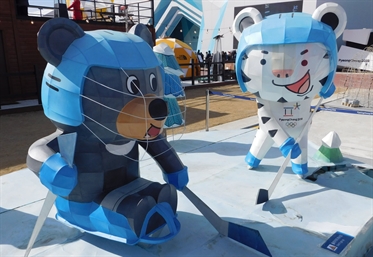Inside the Olympic bubble
Inside the Olympic bubble
What it’s like to cover hockey at the Games

 Olympic mascot Soohorang (right) and Paralympic mascot Bandabi (left) play hockey together at the Gangneung Olympic Park. Photo: Lucas Aykroyd
Olympic mascot Soohorang (right) and Paralympic mascot Bandabi (left) play hockey together at the Gangneung Olympic Park. Photo: Lucas Aykroyd
If you have ever asked yourself such questions and answered “Yes!”, you are likely a hockey journalist covering the 2018 Winter Olympics in PyeongChang, Korea. It’s a blurry, surreal, and amazing journey, especially if you are striving to ensure that all eight women’s teams and all 12 men’s teams receive great coverage on the IIHF website. Here’s what it’s like.
You mostly shuttle back and forth between the Gangneung Hockey Centre and the Kwandong Hockey Centre to chronicle multiple games each day, but there are always different diversions.
For example, perhaps you make a rare foray to the Main Press Centre in the Mountain Cluster to pick up a media welcome package. Spontaneously, you pop into Lindsey Vonn’s press conference, where the American skier emotes about her late grandfather, her Norwegian confidantes on the World Cup circuit, and her little dog Lucy. You also spot Star Wars-style robots meandering through the spacious corridors, vacuuming the carpet and offering visitors bottles of water.
It would all be quite jaw-dropping even if there weren’t statues of silver, anatomically correct gentlemen with hooded heads outside the Main Press Centre.
Amid all the pomp, hype and intensity of the Games, you can sense the passion, purpose, and pride of the Korean people. Korea is now one of just nine countries that have hosted both a Summer and Winter Olympics, and PyeongChang is a worthy successor to Seoul 1988.
Covering these Olympics, you know you’re only scraping the history and culture of the ancient Land of the Morning Calm as you travel between venues in a multifarious landscape of vast fields, pine trees, isolated restaurants, modern apartment buildings, PyeongChang mascot statues, and busy but orderly traffic.
Even when the sun is shining, the temperatures are chilly, as befits a Winter Olympics. But the PyeongChang Passion Crew of mostly Korean volunteers is warm, curious, and conscientious.
The repeated pat-downs and metal detectors prior to entering the arenas are thorough but quick and painless. And everyone can have a good laugh when one slightly overzealous guard insists on verifying first-hand that your hand sanitizer is, well, actually hand sanitizer.
You must make sure you wear your official credential around your neck at all times. At the 2001 IIHF Ice Hockey World Championship in Germany, one writer forgot his credential at the hotel on the gold medal game day and did not have time to go back, so he was spirited past security in the midst of a pack of smiling colleagues. That would not work today at the 2018 Olympics since each credential is electronically scanned as you enter and a giant image of your face pops up on a nearby screen.
There are many charming moments when English-speaking journalists encounter “lost in translation” questions. One mentions that a local shuttle driver inquired when he sat down inside the vehicle: “Do you have places that are not comfortable?” Another was asked: “Would you like to ride gunshot?” Of course, English-speaking journalists cannot justify chuckling too much since our Korean is generally limited to “Kamsa hamnida!” (“Thank you!”) and “Annyeong haseyo!” (“Hello!”).
When you’re in the venue media centre, a large white tent outside the arena, it is a cast of familiar faces. Hockey journalists are a committed and hardy breed – lifers, mostly. The setting is also familiar: coffee machines, big-screen TVs, fluorescent lights, and stacks of game notes and statistics abound. In that environment, even if you’re at the 2018 Olympics in Korea, you could equally well be at the 2006 Olympics in Italy, the 2009 IIHF Ice Hockey World Championship in Switzerland, or the 2016 World Juniors in Finland. The key difference, of course, is that the number of journalists relentlessly updating social media increases every year.
It’s an environment where you can nerd out on the most minute points of hockey history. (“Really? Jocelyne Lamoureux-Davidson’s two goals in six seconds against the Russian women was even faster than Carl-Goran Oberg’s eight-second record from 1960? That’s cool! Hey, wasn’t Oberg the one who threw his broken stick into the Canadian bench and cut Father David Bauer?” And so on.)
It’s also a sharing economy when it comes to player quotes. (“I missed Kovalchuk’s scrum. Can you send me whatever he said about the Americans?”) For general amusement, you can even dig up a YouTube video of an Olympic Information Service reporter interviewing legendary Canadian women’s goalie Manon Rheaume 20 years ago, make him watch it, and ask him with a straight face: “Can you identify this guy?”
Does the tournament fly by or is it a marathon? That depends on how you feel on any given day. You’ll likewise hear players describe the Olympics in the same breath as both a “short tournament” and a “long tournament.” There are so many moving parts to keep track of. Did Canada cancel its practice? Which North Korean female players will crack today’s roster of the unified Korean team? How many minutes will Rasmus Dahlin log on the Swedish power play?
If you’re fully focused on hockey, following other Olympic sports can be a challenge. Fortunately, the venue shuttles have TVs showing highlights – albeit mainly short-track speed skating with Korean broadcasters whose urgent jubilation rivals that of Brazilian football commentators.
Even though the venues for curling, speed skating, and figure skating are within walking distance from the Gangneung Hockey Centre, you’ll likely have to content yourself with occasional strolls around the Olympic Park to soak up the vibe. (The lineups at the Super Store selling Olympic souvenirs are as daunting as the Canadian men’s defence was in Sochi.) From the giant French fries outside McDonald’s to the 3D paper sculptures of Olympic mascot Soohorang and Paralympic mascot Bandabi playing hockey together, it’s a whimsical blend of Disney, Dali, and anime.
Really, there is almost never down-time. You're constantly brainstorming, researching, and typing. And sports journalism is not a field in which this proverb applies: “Early to bed and early to rise/Makes a man healthy, wealthy and wise.” Especially when the 21:10 game goes to a shootout, you will definitely be “Living After Midnight,” to quote Judas Priest, one of the more popular 1980s metal artists at the Kwandong Hockey Centre along with Quiet Riot and Metallica. (Health, wealth, and wisdom – that’s a whole different discussion.)
How do you stay in shape? Well, most hockey journalists don’t do 1,000 squats a day like Jaromir Jagr, but they do get their thighs burning as they run up and down the stairs between the mixed zone (for post-game interviews) and the press tribune. Over and over again. Often at high speed.
As one wag put it: “The best games for the fans are the worst for the journalists.” It is much easier to compose a game story for a routine 5-1 win than it is, say, when Germany nips Switzerland 2-1 in overtime. That means a lot of sprinting. (Thanks a lot, Yannic Seidenberg! Thanks a lot!)
The post-game interviews are an interesting juggling act. Since the players stride quickly through the mixed zone, one must decide whether to grab the low-demand if quotable fourth-liner or wait for the elite veteran of few words who just got the winner but is doing 10 minutes’ worth of TV before getting to the print and web writers. Of course, when that veteran shows up, he or she may be interrogated for long periods in Czech, German or Finnish before switching his or her attention to the English-speaking media. As a journalist, you must be as opportunistic as Phil Esposito banging in rebounds.
If all that chasing after players isn’t enough exercise for you, hit the hotel gym in the morning. It is refreshing to see that retired stars don’t abandon fitness – especially if they’re doing TV broadcasts during these Olympics. There’s Yashin, working his abs. There’s Cassie Campbell and Cheryl Pounder doing squats and running on the treadmill. There’s Kim Martin, getting her heart rate up on the elliptical trainer.
When you refuel at the breakfast buffet, you might even spot figure skating legend Katarina Witt enjoying her morning coffee. In this go-go-go environment, you must focus on getting sufficient calories for the day ahead, whether you lean toward spicy octopus (kind of rubbery, in case you’re curious), beef bulgogi, and fried rice, or scrambled eggs, waffles, and sliced kiwi. Later, you may find yourself living off instant ramen, power bars, and bananas if you can’t find time for lunch or dinner between games, interviews, and other assignments.
Hockey journalism hasn’t officially been made an Olympic sport – yet. Seriously, although the players deserve the glory for the thousands of hours of training they put in and their willingness to risk themselves under the magnifying glass, covering an Olympics offers an abundance of fun, intensity, and wonder for journalists as well. And unlike the players, who may get eliminated at any point, journalists always make it to the gold medal game.
After you’ve covered the glories of PyeongChang, it makes you excited about chronicling what’s to come in Beijing in 2022.
Back to Overview











































